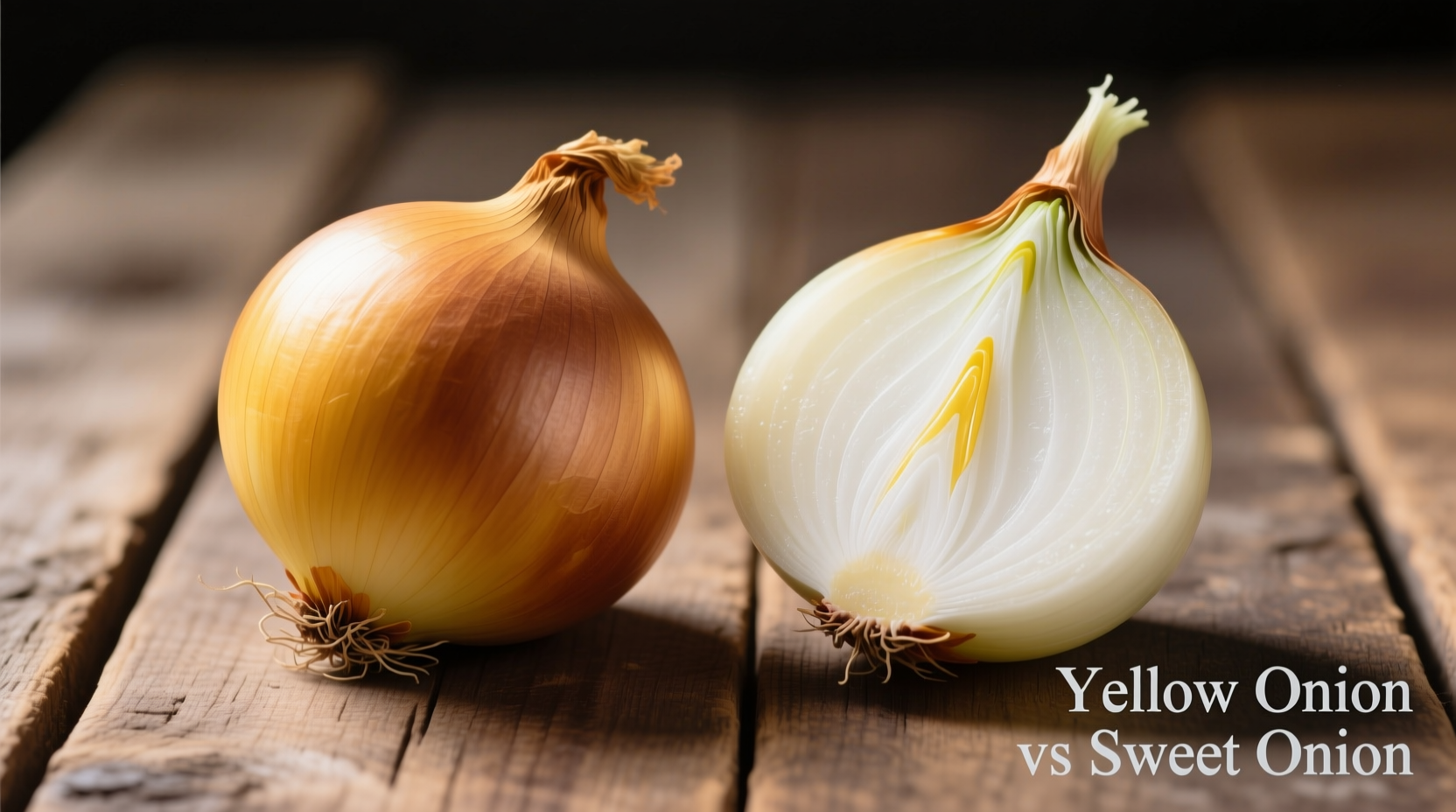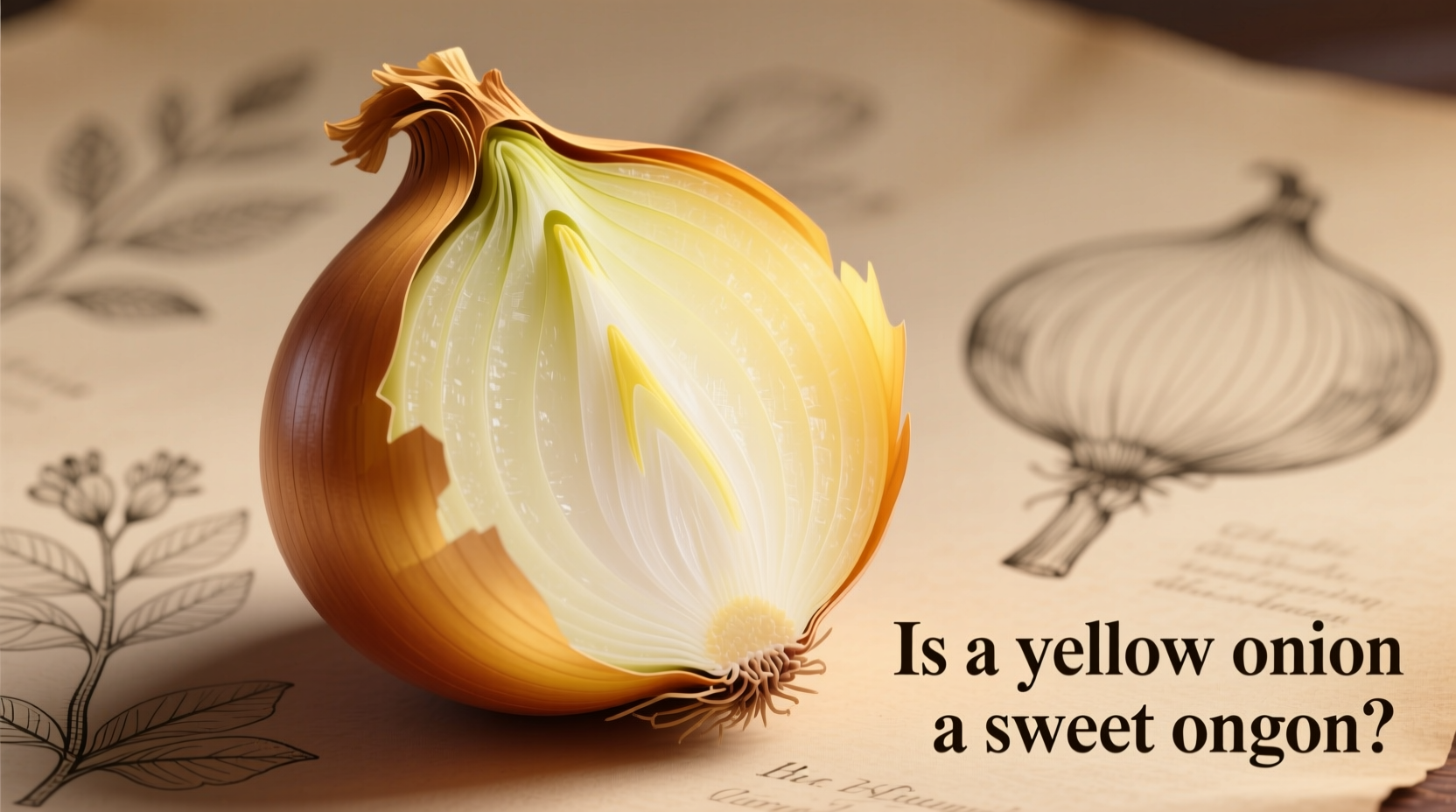Confused about onion varieties? You're not alone. Many home cooks mistakenly believe yellow onions and sweet onions are interchangeable, but understanding their distinct characteristics can transform your cooking results. This guide cuts through the confusion with science-backed differences, practical substitution advice, and clear visual identification tips.
Understanding Onion Classification
Onions are categorized primarily by color and flavor profile, not by sweetness alone. The common misconception that "yellow equals sweet" stems from inconsistent grocery store labeling and regional naming variations. Let's clarify the actual differences using verified agricultural data.
| Onion Type | Sugar Content | Sulfur Compounds | pH Level | Best Uses |
|---|---|---|---|---|
| Yellow Onions | 4-5% | 150-200 mg/100g | 5.0-5.3 | Sautéing, roasting, soups, stews |
| Sweet Onions | 5-7% | 50-100 mg/100g | 5.3-5.8 | Raw applications, caramelizing, grilling |
| White Onions | 3-4% | 180-220 mg/100g | 4.8-5.1 | Mexican cuisine, salsas, pickling |
This nutritional comparison, based on USDA Agricultural Research Service data, shows why sweet onions deliver that characteristic mild flavor. The lower sulfur content directly impacts both taste and tear production - sweet onions make you cry less because they release fewer syn-propanethial-S-oxide compounds when cut.
Yellow Onions: The Kitchen Workhorse
Yellow onions (Allium cepa var. cepa) constitute about 85% of onions grown in the United States according to the USDA National Agricultural Statistics Service. Their coppery skin and white to pale yellow flesh contain higher levels of allyl propyl disulfide, the compound responsible for their sharp bite.
When cooked, yellow onions undergo a remarkable transformation. Their higher sugar content relative to white onions (though less than sweet varieties) creates exceptional caramelization. Professional chefs prefer yellow onions for foundational cooking because their robust flavor holds up in long-simmered dishes like French onion soup or beef bourguignon.
Sweet Onions: The Mild Alternative
Sweet onions aren't a single variety but a category including Vidalia (Georgia), Walla Walla (Washington), and Maui (Hawaii) onions. These varieties earned their sweet designation through specific growing conditions - the low-sulfur soils in their designated regions produce onions with sugar content up to 25% higher than standard yellow onions.
The Vidalia Onion Committee, established under USDA marketing orders, requires certified Vidalias to measure no more than 5.0 on the pyruvate scale (a measure of pungency) and have minimum sugar content of 5.5%. This regulatory standard ensures consistent mildness that defines true sweet onions.

When Substitution Matters: Practical Cooking Guide
Understanding when you can substitute yellow for sweet onions (and vice versa) prevents recipe disasters. Consider these evidence-based guidelines:
- Raw applications: Never substitute yellow for sweet onions in salads, salsas, or sandwiches. The higher sulfur content in yellow onions creates an unpleasant sharpness when uncooked.
- Caramelizing: Yellow onions actually caramelize better due to their higher sugar-to-water ratio. Sweet onions contain more water (90% vs 89%), which prolongs the cooking process.
- Storage differences: Yellow onions last 2-3 months in cool, dark storage while sweet onions last only 1-2 weeks due to higher water content. Never refrigerate either type until cut.
- Flavor impact: In dishes with short cooking times (stir-fries, quick sautés), yellow onions will dominate the flavor profile, while sweet onions blend more subtly.
Common Onion Misconceptions Debunked
Myth: "Red onions are sweeter than yellow onions."
Fact: Red onions have similar pungency to yellow onions but contain anthocyanins that create a slightly different flavor profile. They're not inherently sweeter.
Myth: "All yellow-skinned onions are sweet onions."
Fact: Many grocery stores mislabel regular yellow onions as "sweet" during peak growing seasons. True sweet onions will be labeled with their specific variety (Vidalia, Walla Walla, etc.).
Myth: "Sweetness depends only on the onion variety."
Fact: Growing conditions significantly impact sweetness. Onions grown in low-sulfur soil with adequate water develop higher sugar content regardless of variety.
Choosing the Right Onion for Your Recipe
Follow this decision tree for perfect onion selection:
- Will the onion be served raw?
- Yes → Choose sweet onion or shallot
- No → Proceed to next question
- Is this a long-cooking dish (30+ minutes)?
- Yes → Yellow onion preferred for depth of flavor
- No → Sweet onion for subtle flavor integration
- Do you want pronounced onion flavor?
- Yes → Yellow onion
- No → Sweet onion
Remember that cooking method affects flavor development. Roasting concentrates natural sugars in all onion varieties, while boiling leaches flavor compounds into the water. For maximum flavor retention, sauté or roast rather than boil.











 浙公网安备
33010002000092号
浙公网安备
33010002000092号 浙B2-20120091-4
浙B2-20120091-4